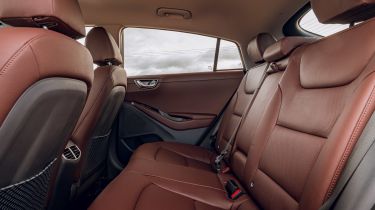Hyundai Ioniq (2016-2022) review - Practicality, comfort and boot space
Spacious boot and decent rear passenger space make the Ioniq a capable family car
The 443-litre boot puts the Ioniq ahead of the Toyota Prius in terms of load space. This small advantage is helped by a lithium-ion battery pack underneath the rear bench that has allowed Hyundai’s engineers to maximise luggage room.
However, it’s not quite as large as the Toyota with the rear seats folded, offering 1,505 litres compared with 1,558 litres in the Prius, although most people will benefit more from the roomier five-seat layout.
A space-saver spare wheel comes as standard, so the underfloor boot storage is limited. However, with plenty of trinket trays, cubbies and cup-holders – as well as good-sized door bins – storage is a match for the level of passenger space on offer.
Size
At 4,470mm long, 1,820mm wide and 1,450mm tall, the Ioniq is a little larger than a Toyota Prius and it shows in its more spacious boot.
Leg room, head room & passenger space
Space in the back is decent enough, but the aerodynamic shape of Ioniq does limit headroom slightly. Those over six feet tall may feel their heads brushing against the roof – the more boxy Nissan Leaf offers more space inside.
Boot
For a hybrid, the Ioniq has a surprisingly spacious load area, which measures in at 443 litres. Because Hyundai has located the batteries beneath the rear seats rather than under the boot floor, the Ioniq is the most spacious hybrid on the market when it comes to load capacity. The electric model isn’t quite as spacious, with a 350-litre boot, and the PHEV has the smallest boot of the lot; but, it still has a useful 341 litres - about the same a small family hatchback.




